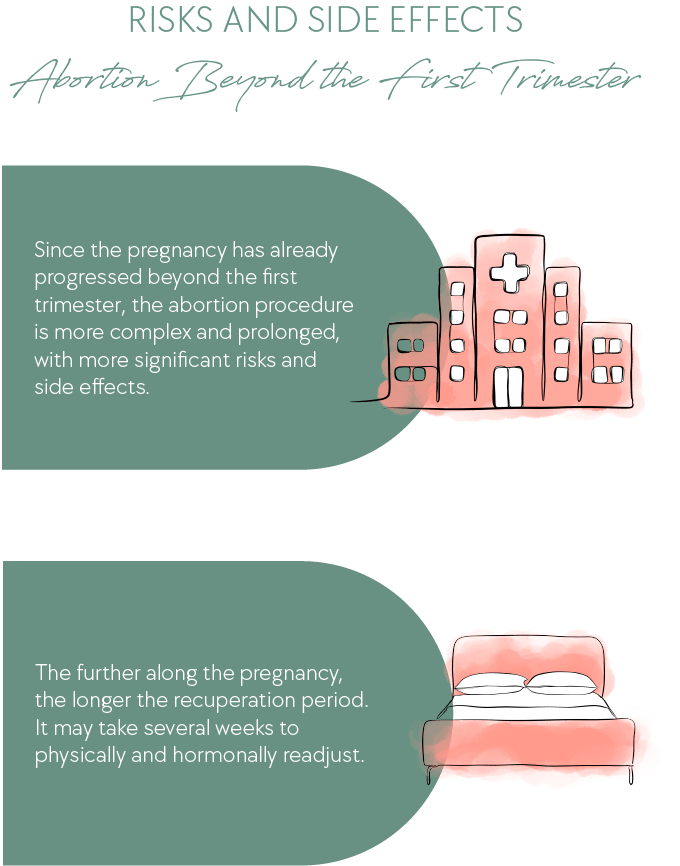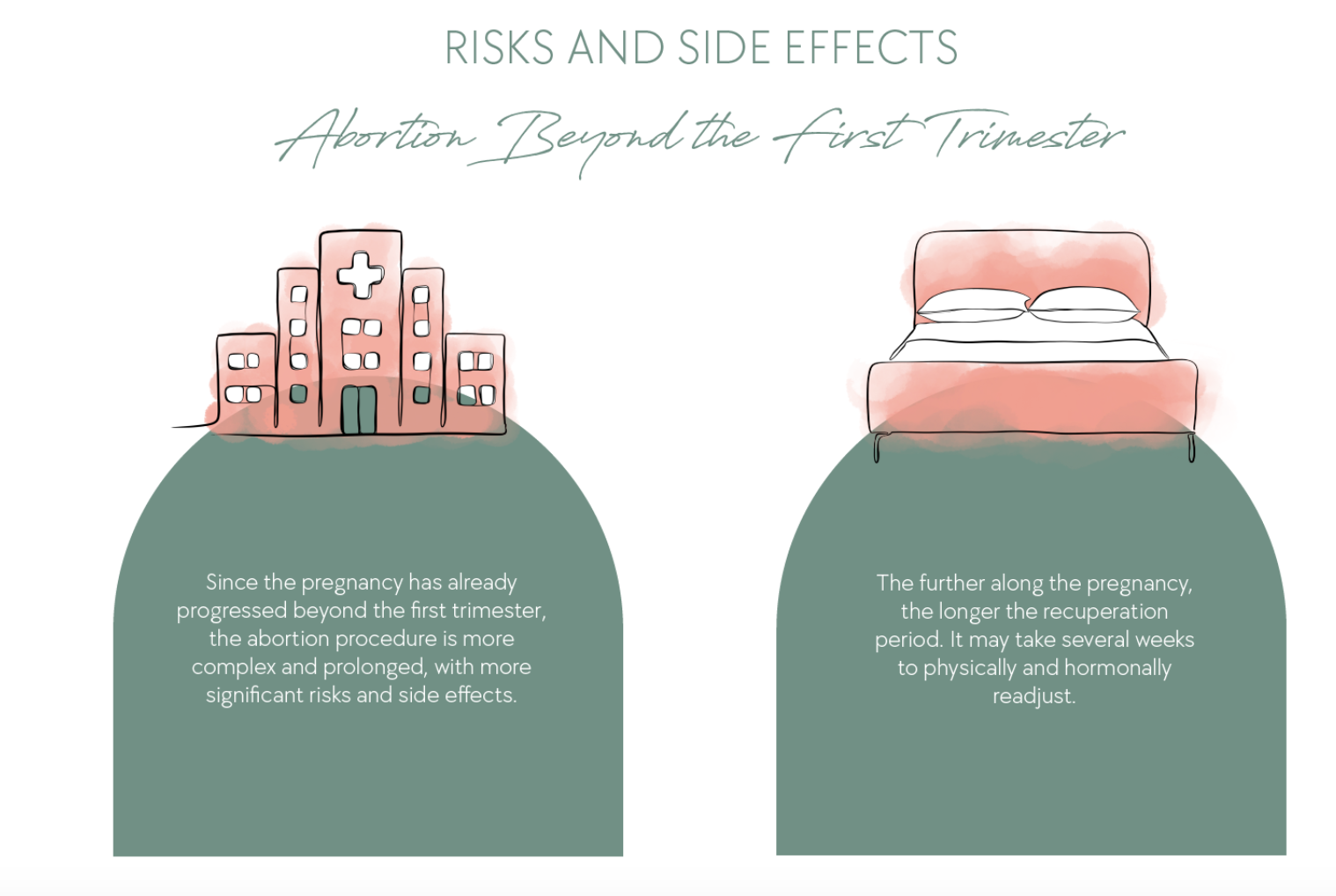Abortion by Inducing Labor
🏥 Abortion Methods: What Do I Need to Know? — Take the test
Induction abortion is a medical abortion using the same two-pill combination as the abortion pill.
Dosages differ, and the effect is more severe.
Induction abortions may take 24 hours or longer and must be completed at a hospital or clinic because of the more significant risks and side effects.
Abortion Methods: What Do I Need to Know? Test
Considering abortion and wondering what method to choose? Answer three multiple-choice questions about your situation and receive a professional evaluation within seconds on your screen!
What Is Abortion by Induction?
Induction abortion is a second and third-trimester medical abortion method. It involves administering medication vaginally, under the tongue, or as an injection to induce labor and delivery. The procedure is completed in two steps, identical to early medication abortion. The same medication combination is used: Mifeprex® (mifepristone), followed by Cytotec® (misoprostol), but the process is more prolonged and painful.
It is possible to use misoprostol only, as practiced in South Africa.
In the USA, 2-5% of late-term abortions are induced. Other countries, such as Canada, rarely offer D&E abortions and therefore primarily rely upon the induction method.
For safety reasons, induction abortions are performed in hospitals or clinics.
- Find out if second-trimester abortions are legal in your area by going to Until When Can I Get an Abortion?
Go to Abortion Methods to see how the different methods compare.
Go to Late-Term Abortion to learn about exceptions, regulations, and procedures.
Induction abortions are more expensive than D&Es because of the extended time spent in the medical facility.
Wondering how much you should expect to pay? Go to How Much Does an Abortion Cost?
Induction Abortion — The Procedure
1. Preparation and First Medication
Consent Forms and Payment
Abortions are only performed with the written permission of the woman. By law, abortion is a free choice and may not be coerced.
Go to Coerced Abortion if you feel pressured into having an abortion.
Bloodwork and Ultrasound
Before initiating dilation, blood is drawn to determine your Rh factor and blood type in case the need for blood transfusions arises.
A pre-abortion ultrasound establishes the gestational age and reveals the position of the fetus and placenta.
Feticide
An injection to induce fetal demise is sometimes given through the woman's abdomen or cervix. This elective step is commonly taken beyond the 22nd week of pregnancy to prevent a live birth.
Mifeprex®
The first medication, Mifeprex®, is given at the abortion facility. It softens and opens the cervix. The woman is free to return home and may start bleeding after 12 hours.
2. Induction (12–48 hours later)
After a day or two, the second phase of the abortion procedure begins with the administration of Cytotec (misoprostol). This medication includes labor and is given every three hours until fetal expulsion. Usually, three to five doses suffice, but up to 12 doses have been used. The further along the pregnancy, the longer the process. The average induction to abortion time is 12–16 hours, but it can take up to three days.
Misoprostol will cause contractions and dilation of the cervix. The sensation is identical to labor. Pain relief is usually given as needed, such as intermittent narcotics, sedatives, or an epidural. Misoprostol can cause side effects, such as nausea and vomiting, fever, and diarrhea.
After the abortion, the woman will remain in the clinic for up to two days, depending on her health.
A follow-up appointment will be given one to two weeks after the abortion. If the reason for the termination is a fetal anomaly, the doctor will then review any post-mortem findings with the parents.
What to Expect After an Abortion by Induction
Side Effects
After the procedure, the uterus will bleed for a few days or even up to two weeks. Cramping may continue for several weeks, causing the uterus to return to its pre-pregnancy size. Lactation is possible, causing breasts to swell, hurt, and leak colostrum.
⚠️ Menstruation usually resumes within four to eight weeks, but conception is possible before your first period.
Things to Avoid
Since the cervix stays slightly open for three to four weeks after the abortion, the following activities should be avoided to prevent infection:
sexual intercourse
tampons
swimming pools/bathtubs
sauna visits
Potential Risks of an Induction Abortion
The risk of complications increases with gestation.
Six percent of induction abortions are incomplete and require surgery for a retained placenta.
Other potential complications include uterine rupture (>0.3%), cervical laceration, hemorrhage requiring transfusion (>1%), and infection (1-3%).


ℹ️ For more information, go to Risks and Side Effects of Abortion.
While it is important to be aware of the physical risks, the emotional repercussions also need to be taken into consideration.
Reasons for an Induction Abortion
The reasons women pursue an abortion by induction are as unique as their lived experiences.
Perhaps you have received the heartbreaking news of a fetal anomaly that is incompatible with life. Now you are wondering whether to have an induction abortion. You had longed for this baby, and you long for it still. An intact delivery would allow you to hold the child and would also allow for an autopsy and burial.
Alternatives to Induction Abortion
Another option for a child with a diagnosis incompatible with life is to have a palliative birth, allowing for a brief time together. This farewell can be helpful in the grieving process.
Use our Fetal Defect Abortion Test to guide you in the decision-making process.
If the disability is not life-threatening, would keeping the baby be worth considering?
Raising a Special Needs Child
Are you encountering a severe medical issue that is putting your life or health at risk?
Use the information provided in Abortion for the Health of the Mother as you determine your next steps.
Perhaps you did not realize you were pregnant until the first trimester had passed, or you could not get an appointment sooner because of finances or abortion restrictions.
Or maybe you are experiencing an unexpected crisis, causing you to doubt whether you should go through with the pregnancy.
Where to Go from Here
Perhaps you stumbled upon this page because you were researching your abortion options. While this article hopefully answered some of your basic questions concerning abortion methods, your concerns naturally go beyond the scope of acquiring knowledge. Are you wondering which path is right for you?
If you feel pressured to make an immediate decision, take a deep breath! You usually do not have to decide on the spot, even if your doctor makes it sound that way. If you are considering a second-trimester abortion, you either live in an area where abortion is unrestricted or you have been granted an exemption for medical reasons. Unless you are experiencing a medical emergency, you have time to consider your next steps and determine which choice you would feel at peace about long term.
We would love to come alongside you as you determine what is right for you.
Use our free tests below as a judgment-free space to determine what you want and how to reach your goals.
⛑ Wondering where to go from here? Take the First Aid Test
⚖️ Wondering whether to have an abortion or not? Take the Abortion Test








